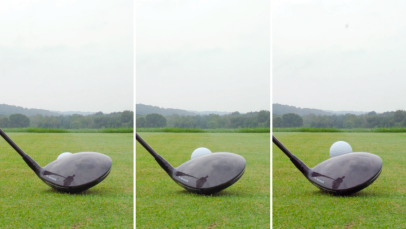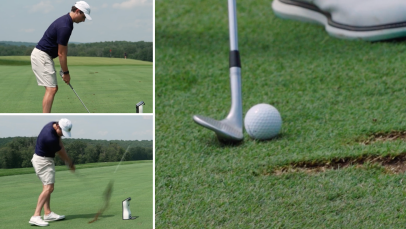Do range balls really perform worse than premium balls? We tested it – Australian Golf Digest

- by Admin
- September 19, 2024

Welcome to MythBusters, a Golf Digest series where we explore answers to some of golf’s most common questions through a series of tests with real golfers. While our findings might fall short of definitive, they still aim to shed new light on topics that have consumed golfers for years.
You warm up on the range, hitting your 9-iron right at the flag 130 yards away. On the first hole—same distance, same club, same swing—the ball flies over the back of the green. What happened?
Unless you’re one of the lucky few whose driving range is stocked with brand new premium golf balls, odds are you’re warming up with a standard range ball. Whether your course uses limited flight versions or a hodge podge of different value brands, all of them have far less sophisticated technology than the premium ball you play on the course.
Standard thinking says that range balls fly shorter than premium brands, but even if this holds true, how much shorter? And is there a difference in spin? To practice and warm up effectively on the range, we need to be able to learn from the shots we’re hitting. In other words, if your 9-iron is consistently flying 130 on the range, knowing what that would be with a high-end ball is the difference between having a birdie putt or a short-sided pitch from over the green.
How does the cheaper technology in range balls affect distance and spin?
Our test
To measure the disparity in carry distance and spin between range balls and premium balls, Golf Digest associate editor and plus handicap Drew Powell hit shots with a gap wedge and driver using a launch monitor at Tamarack Country Club in Greenwhich, Conn.
Powell hit 20 full shots with a 50-degree wedge—10 with a range ball and 10 with a premium ball—and repeated the process with a driver. We alternated which ball we were using to try and avoid any bias or changes in energy level throughout the test.
We used standard, relatively new range balls from a well-known brand. They were not limited flight balls designed to intentionally fly shorter, as some ranges use.
What we found Gap wedge, premium ball:
Avg. carry: 128.1 yardsAvg. spin: 9,523 rpms
Gap wedge, range ball:
Avg. carry: 124.8 yardsAvg. spin: 9,127 rpms
Driver, premium ball:
Avg. carry: 290.1 yardsAvg. spin: 2,366 rpms
Driver, range ball:
Avg. carry: 284.2 yardsAvg. spin: 2,581 rpms
What does it mean?
Our findings confirm the idea that range balls fly shorter than premium balls. With the gap wedge and a premium ball, Powell averaged a carry of 128.1 yards, which is his usual distance with that club. The same swing with a range ball, however, averaged 124.8 yards of carry. While this is less carry than with the premium ball, the difference was only a touch over three yards.
It is worth considering that the balls used were in great condition, and as far as range balls go, they were on the higher end. If your range has older balls with scuffs, you may find that your wedges and short irons fly even shorter than what we found.
There was a significant difference in spin, as well. Powell averaged about 400 fewer rpms of spin with the range ball. When the ball hit the green with a premium ball, it took one hop and spun back significantly. With the range ball, however, the ball took one bounce and stopped. On firmer greens or half-shots, this difference could result in the range ball tumbling forward after landing.
Given that we rarely use range balls on the course, this disparity in spin won’t have a huge effect on your warmup, except that it promoted a lower ball flight and a shorter carry.
As might be expected, the difference in carry distance increased as we moved to the driver. Powell averaged about 290 yards of carry with the premium ball and about 284 yards with the range ball. Looking deeper at the data, the disparity in distance was largely due to how the mishits flew with each.
With the premium ball, mishits stayed in the air longer and none of the 10 shots hit flew shorter than 280 yards. With the range ball, off-center strikes were punished. Three shots carried less than 280 yards, including one drive that only flew 266 yards, 15 yards shorter than the worst drive with the premium ball.
The ceiling—that is, the best drive with each ball—was about the same, however. The farthest drive with a premium ball carried 300 yards, while the best drive with the range ball still carried 297.
This brings us to an interesting point. Yes, the technology in range balls is far less sophisticated than that of tour balls—most range balls use a cheap rubber and have a thicker and firmer outer layer to promote durability. Perhaps equally important, though, is that these range balls often have far looser specs within batches, meaning there can be a great difference in quality from one range ball to the next, even if it is the same brand.
This may help explain why some shots flew so much shorter with a range ball, yet some carried just as far as the high-end balls. Slightly different specs between balls might create inconsistent performance. This may also help explain why with a wedge, the range balls had less spin, but with a driver, they actually had more spin than the premium ball. More testing is needed to confirm this hypothesis.
More Golf Digest MythBusters Golf Digest Logo Does a higher tee really produce more distance? What our test reveals  Golf Digest Logo Does a clean clubface really matter? What our test reveals about dirty clubs and spin
Golf Digest Logo Does a clean clubface really matter? What our test reveals about dirty clubs and spin  Golf Digest Logo Does walking without carrying your bag lead to lower scores? What our modest test reveals What it doesn’t mean
Golf Digest Logo Does walking without carrying your bag lead to lower scores? What our modest test reveals What it doesn’t mean
Given that range balls vary so much between courses, we have to be careful in making broad statements about their performance. Limited-flight balls, for example, will fly much shorter than the new, quality range balls we tested. What’s more, some courses use mid-tier balls—not quite top of the line but also not standard range balls—so those golfers may hardly notice a disparity between their range balls and the ones they play with on the course.
Our test also doesn’t mean that every shot you hit with a premium ball will fly farther than one with a range ball. We presented our data in averages, but some premium-ball shots with a gap wedge, for example, flew shorter than shots with the range balls.
Verdict
Range balls, generally speaking, fly shorter and have more inconsistent carry distances than premium balls. Range balls also produce different spin rates than premium balls. The distance disparity becomes greater as the clubs get longer, and you can expect to see the greatest difference in carry numbers with the driver. When warming up or practicing on the range, it is important to consider what kind of range ball you are using to properly compare your carry numbers on the range versus on the course.
 false Private Tamarack Country Club Greenwich, CT, United States 4.3 78 Panelists
false Private Tamarack Country Club Greenwich, CT, United States 4.3 78 Panelists
Situated within a mecca of great golf courses, Tamarack Country Club stands out as one of the finest. Built by Charles Banks in 1929, the course includes many template holes that were the trademark of Banks’ mentors, Seth Raynor and C.B Macdonald, and a few great original holes on the back nine. The course is memorable for its massive scale throughout the property, often allowing players to recover from wayward misses. Though Tamarack delivers options in where you can hit it, the brawny course makes it difficult to score if you’re not in the correct spots. View Course
This article was originally published on golfdigest.com
The Latest News
-
December 29, 2024Aussie champion slams doubles partner’s doping ban ‘stitch-up’
-
December 29, 2024Sports News Today Live Updates on December 29, 2024: Konery Humpy crowned 2024 FIDE Women’s World Rapid Champion for record second time
-
December 29, 2024Indian superstar mocks Sam Konstas after brutal early wicket
-
December 28, 2024‘Never seen this’: Aussies left baffled by umpire’s ‘rushed’ call in ‘farcical’ scenes
-
December 28, 2024Sutherland set for greatness after stellar start to career | cricket.com.au





